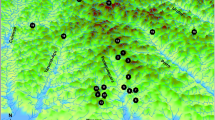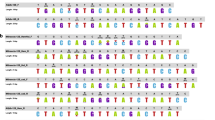Abstract
We used microsatellites to assess genetic diversity and spatial structuring of the invasive apomictic New Zealand mudsnail (Potamopyrgus antipodarum) in the initial focal area of its recent North American invasion, a portion of the upper Snake River basin (Idaho) that is segmented by a series of hydropower dams. Thirty-four samples (812 total snails) from a 368 km reach of this drainage were genotyped for six loci. Sixty-five distinct clones were detected and grouped into four divergent clusters based on chord distances. Genetic structuring of populations was generally low. Our results indicate that the founding population(s) of this invasion was composed of a small number of putative clonal lineages which spread rapidly within this fragmented watershed owing to the enhanced dispersal ability of these parthenogens. The substantial genetic variation documented in this study suggests that caution should be used in the application of biological control measures for this pest species.




Similar content being viewed by others
References
Alonso A, Castro-Díez P (2008) What explains the invading success of the aquatic mud snail Potamopyrgus antipodarum (Hydrobiidae: Mollusca)? Hydrobiol 614:107–117
Anderson TR (2006) New Zealand Mudsnail Potomopyrgus [sic] antipodarum. In: Boersma PD, Reichard SH, Van Buren AN (eds) Invasive species in the Pacific Northwest. University of Washington Press, Seattle, pp 102–103
Aquatic Nuisance Species Task Force (ANSTF) (2009) New Zealand mudsnail (Potamopyrgus antipodarum) http://www.anstaskforce.gov/spoc/nzms.php (accessed 23/II/2009)
Armour JA, Crosier LM, Jeffreys AJ (1996) Distribution of tandem repeat polymorphisms within minisatellite MS621 (D5S110). Ann Hum Genet 7:11–20
Bohonak AJ (2002) IBD (Isolation by distance): a program for analyses of isolation by distance. J Hered 93:153–154
Boutin-Ganache I, Raposo M, Raymond M, Deschepper CF (2001) M13-tailed primers improve the readability and usability of microsatellite analyses performed with two different allele-sizing methods. Biotech 2001:24–26, 28
Bowler PA (1991) The rapid spread of the freshwater hydrobiid snail Potamopyrgus antipodarum Gray in the middle Snake River, southern Idaho. Proc Desert Fish Counc 21:173–179
Bowler PA, Frest TJ (1996) The advancing distribution of the New Zealand mud snail, Potamopyrgus antipodarum (Gray), in North America. Am Malacol Union 62nd Annual Meeting Program and Abstracts:31
Bucklin A (1992) Use of formalin-preserved samples for molecular analysis. Newsl Crustac Mol Tech 2:3
Cavalla-Sforza LL, Edwards AWF (1967) Phylogenetic analysis: models and estimation procedures. Evol 21:550–570
Dybdahl MF, Lively CM (1995) Diverse, endemic and polyphyletic clones in mixed populations of a freshwater snail (Potamopyrgus antipodarum). J Evol Biol 8:385–398
Ellstrand NC, Roose ML (1987) Patterns of genotypic diversity in clonal plant species. Am J Bot 74:123–131
Excoffier L, Smouse PE, Quattro JM (1992) Analysis of molecular variance inferred from metric distances along DNA haplotypes: application to human mitochondrial DNA restriction data. Genet 131:479–491
Felsenstein J (1995) PHYLIP (Phylogeny Inference Package) Version 3.57c. Distributed by the author. University of Washington, Seattle
Fox JA, Dybdahl MF, Jokela J, Lively CM (1996) Genetic structure of coexisting and clonal subpopulations in a freshwater snail (Potamopyrgus antipodarum). Evol 50:1541–1548
Hall RO Jr, Dybdahl MF, VanderLoop MC (2006) Extremely high secondary production of introduced snails in rivers. Ecol Appl 16:1121–1131
Hauser L, Carvalho GR, Hughes RN, Carter RE (1992) Clonal structure of the introduced freshwater snail Potamopyrgus antipodarum (Prosobranchia: Hydrobiidae), as revealed by DNA fingerprinting. Proc R Soc Lond B249:19–25
Hughes RN (1996) Evolutionary ecology of parthenogenetic strains of the prosobranch snail, Potamopyrgus antipodarum (Gray) (= P. jenkinsi (Smith). Malacol Rev Suppl 6:101–113
Jacobsen R, Forbes VE, Skovgaard O (1996) Genetic population structure of the prosobranch snail Potamopyrgus antipodarum (Gray) in Denmark using PCR-RAPD fingerprints. Proc R Soc Lond B263:1065–1070
Jokela J, Dybdahl MF, Lively CM (1999) Habitat-specific variation in life-history traits, clonal population structure and parasitism in a freshwater snail (Potamopyrgus antipodarum). J Evol Biol 12:350–360
Kalyoncu H, Barlas M, Yildirim MZ, Yorulmaz B (2008) Gastropods of two important streams of Gökova Bay (Muğla, Turkey) and their relationships with water quality. Int J Sci Technol 3:27–36
Kerans BL, Dybdahl MF, Gangloff MM, Jannot JE (2005) Potamopyrgus antipodarum: distribution, density, and effects on native macroinvertebrate assemblages in the Greater Yellowstone Ecosystem. J N Am Benthol Soc 24:123–138
Kornijów R, Szcerbowski JA, Krywosz BartelR (2001) The macrozoobenthos of the Iraqui Lakes Tharthar, Habbaniya and Razzazah. Archiv Pol Fish 9(suppl. 1):127–145
Loo SE, MacNally R, Lake PS (2007) Forecasting New Zealand mudsnail invasion range: model comparisons using native and invaded ranges. Ecol Appl 17:181–189
Lysne S, Koetsier P (2008) Comparison of Desert Valvata snail growth at three densities of the invasive New Zealand mudsnail. West N Am Nat 68:103–106
Meirmans PG, Van Tienderen PH (2004) GENOTYPE and GENODIVE: two programs for the analysis of genetic diversity of asexual organisms. Mol Ecol Notes 4:792–794
Montana State University (MSU) (2009) New Zealand mudsnails in the western USA. http://www.esg.montana.edu/aim/mollusca/nzms/status.html (Accessed 23/II/2009)
Parker ED Jr (1979) Ecological implications of clonal diversity in parthenogenetic morphospecies. Am Zool 19:753–762
Ponder WF (1988) Potamopyrgus antipodarum—a molluscan colonizer of Europe and Australia. J Moll Stud 54:271–285
Proctor T, 18 co-authors (2007) National management and control plan for the New Zealand mudsnail (Potamopyrgus antipodarum). Prepared for the Aquatic Nuisance Species Task Force by the New Zealand Mudsnail Management and Control Plan Working Group. Available from http://www.anstaskforce.gov/Documents/NZMS_MgmtControl_Final.pdf (accessed 23/II/2009)
Richards DC, Cazier LD, Lester GT (2001) Spatial distribution of three snail species, including the invader Potamopyrgus antipodarum, in a freshwater spring. West N Am Nat 61:375–380
Riley LA, Dybdahl MF, Hall RO Jr (2008) Invasive species impact: asymmetric interactions between invasive and endemic freshwater snails. J N Am Benthol Soc 27:509–520
Schreiber ESG, Glaister A, Quinn GP, Lake PS (1998) Life history and population dynamics of the exotic snail Potamopyrgus antipodarum (Prosobranchia: Hydrobiidae) in Lake Purrembete, Victoria, Australia. Mar Freshw Res 49:73–78
Städler T, Frye M, Neiman M, Lively CM (2005) Mitochondrial haplotypes and the New Zealand origin of clonal European Potamopyrgus, an invasive aquatic snail. Mol Ecol 14:2465–2473
Stock M, Lamatsch DK, Steinlen C et al (2002) A bisexually reproducing all-triploid vertebrate. Nat Genet 30:325–328
Suomalainen E (1950) Parthenogenesis in animals. Adv Genet 3:193–253
Suomalainen E, Saura A, Lokki J (1987) Cytology and evolution in parthenogenesis. CRC Press, Boca Raton, Florida
Takezaki N, Nei M (1996) Genetic distances and reconstruction of phylogenetic trees from microsatellite DNA. Genet 144:389–399
Urabe M (2007) The present distribution and issues regarding the control of the exotic snail Potamopyrgus antipodarum in Japan. Jpn J Limnol 68:491–496 (Japanese, with English abstract)
Wallace C (1985) On the distribution of the sexes of Potamopyrgus jenkinsi (Smith). J Moll Stud 51:290–296
Wallace C (1992) Parthenogenesis, sex and chromosomes in Potamopyrgus. J Moll Stud 58:93–107
Wattier R, Engel CR, Saumitou-Laprade P, Valero M (1998) Short allele dominance as a source of heterozygote deficiency at microsatellite loci: experimental evidence at the dinucleotide locus Gv1CT in Gracilaria gracilis (Rhodophyta). Mol Ecol 7:1569–1573
Weetman D, Hauser L, Carvalho GR (2001) Isolation and characterisation of di- and trinucleotide microsatellites in the freshwater snail Potamopyrgus antipodarum. Mol Ecol Notes 1:185–187
Weetman D, Hauser L, Carvalho GR (2002) Reconstruction of microsatellite mutation history reveals a strong and consistent deletion bias in invasive clonal snails, Potamopyrgus antipodarum. Genet 162:813–822
White MJD (1973) Animal cytology and evolution, 3rd edn. Cambridge, London
Winterbourn M (1970) The New Zealand species of Potamopyrgus (Gastropoda: Hydrobiidae). Malacol 10:283–321
Zaranko DT, Farara DG, Thompson FG (1997) Another exotic mollusc in the Laurentian Great Lakes: the New Zealand native Potamopyrgus antipodarum (Gray 1843) (Gastropoda, Hydrobiidae). Can J Fish Aquat Sci 54:809–814
Acknowledgments
Barry Bean and Mike Stephenson (IPC) provided a large amount of field assistance. Mike Radko (IPC) calculated the stream distances between sampling sites and Molly Ryan (Smithsonian Institution) assisted with preparation of the figures. Tom Quinn (University of Denver) and Sara Oyler-McCance (United States Geological Survey) generously shared bench space and equipment in the Rocky Mountain Center for Conservation Genetics and Systematics. This project was supported (in part) by a contract (to RH) from the Idaho Power Company (Award #1600).
Author information
Authors and Affiliations
Corresponding author
Appendix
Appendix
See Appendix Table 4.
Rights and permissions
About this article
Cite this article
Hershler, R., Liu, HP. & Clark, W.H. Microsatellite evidence of invasion and rapid spread of divergent New Zealand mudsnail (Potamopyrgus antipodarum) clones in the Snake River basin, Idaho, USA. Biol Invasions 12, 1521–1532 (2010). https://doi.org/10.1007/s10530-009-9564-7
Received:
Accepted:
Published:
Issue Date:
DOI: https://doi.org/10.1007/s10530-009-9564-7




